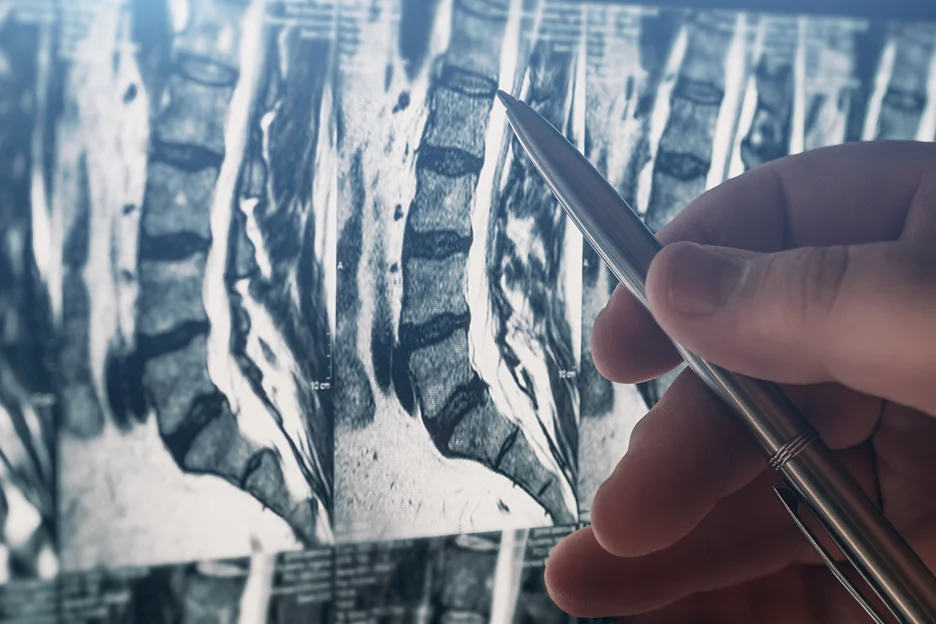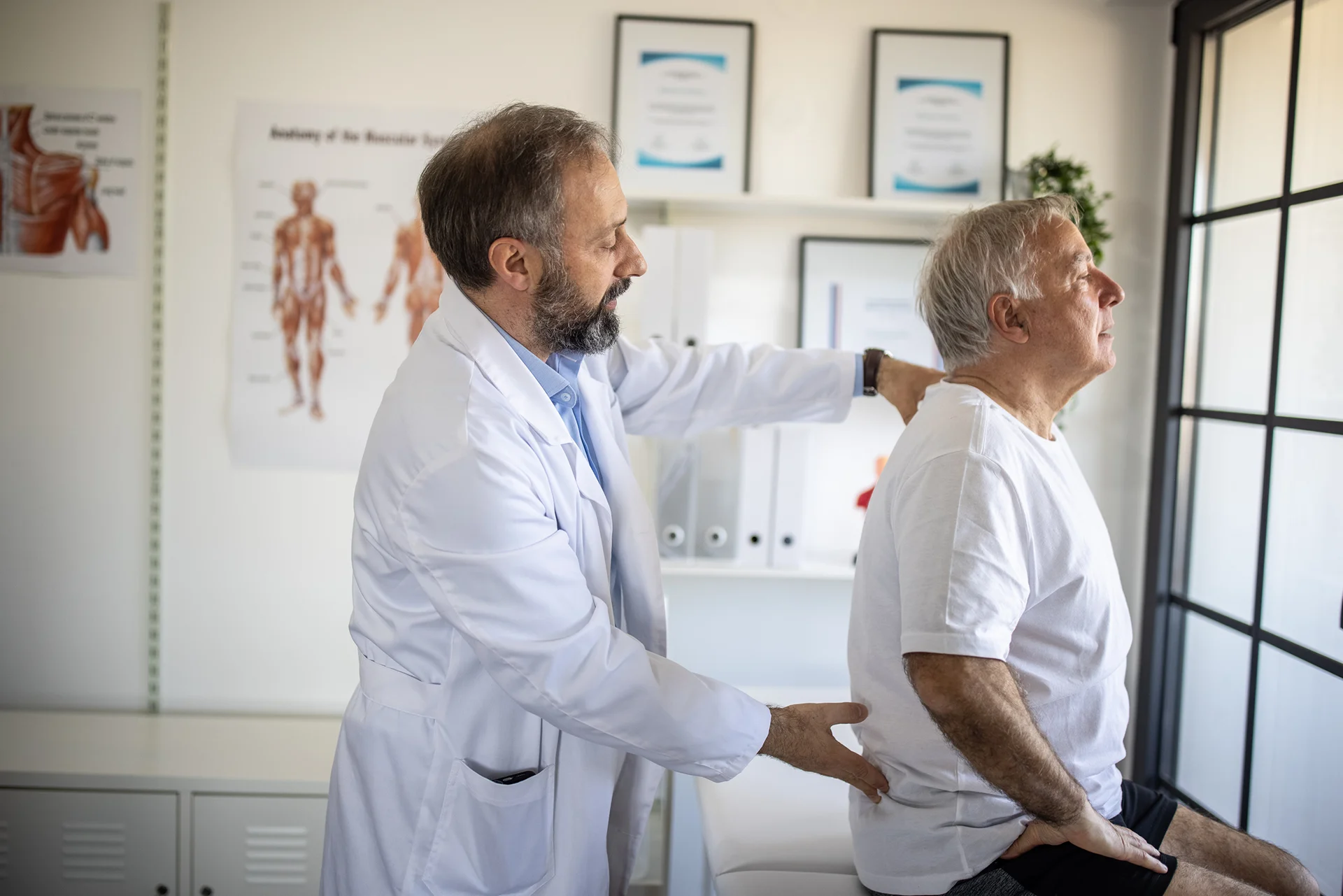Few things can zap your energy faster than waking up to lower back pain concentrated on your left side. While the discomfort may come and go, chronic back pain can interfere with your daily activities and quality of life.
But don’t just grit your teeth and accept it – educating yourself on all aspects of lower back pain is the first step to getting real answers and long-lasting relief. Get to the bottom of your back pain and craft a treatment plan to significantly reduce if not eliminate the pain – and keep it away for years to come.
The Complex Causes of Pain on Your Lower Left Back
Lower left back pain originates from a wide range of anatomical structures in the lumbar region. For instance, the lumbar spine contains five vertebrae (L1-L5) that provide both stability and flexibility through a range of motion.
- Discs between the vertebrae act as shock absorbers and allow the back to flex and twist.
- Major nerves branch out from the spinal cord at the lumbar level to control sensation and movement in the lower body.
- Numerous muscles like the erector spinae allow the back to bend and rotate while ligaments and tendons provide structural support. Any injury, dysfunction, or deterioration involving these structures can produce lower left back pain.
Beyond the muscles and bones, a variety of internal organs can also generate pain that is felt in the lower back.
- Kidney stones, infections, or structural problems with the left kidney often cause lumbar pain on that side. Issues with abdominal organs like the pancreas, intestines, uterus, and ovaries may also lead to back pain.
- Even pregnancy can put pressure on muscles and nerves that results in a persistent ache.
What’s Causing That Pain in Your Lower Left Back?
Musculoskeletal Problems
For instance, twisting or lifting something with poor form can overstretch the muscles and connective tissues. As a result, the resulting inflammation leads to spasms and soreness localized on the left side. Likewise, sudden movements like swinging a golf club or reaching for a purse on a high shelf commonly produce this type of strain.
It doesn’t stop there because lumbar muscle tension and trigger points may also arise from repetitive actions or prolonged sitting with poor posture.
Issues with the spinal structures themselves often cause more severe, chronic back pain.
- A herniated disc occurs when the jelly-like nucleus pushes through the outer fibrous ring and irritates or compresses a nerve root.
- Degenerative disc disease leads to thinner, less flexible discs that reduce spinal stability.
- Spinal stenosis describes an abnormal narrowing of the spinal canal that restricts the nerve pathways.
- Spondylolisthesis involves a vertebra slipping out of position and placing pressure on nerves.
- Conditions like scoliosis and osteoporosis are likely culprits of mechanical back pain.
Kidney Problems
Given the proximity of your left kidney to the left side of your lower back, any problems with that organ can generate lumbar pain in that area.
- Kidney stones form when minerals crystallize in the urinary tract, blocking the flow of urine. As the stones move through the narrow ureter on their way to the bladder, intense pain results.
- Infection, injury, or structural abnormalities in the left kidney produce inflammation and swelling that again transfers discomfort to the lower back.
Kidney issues often produce additional symptoms like nausea, vomiting, bloody urine, or frequent urination.
As such, specialized testing of urine and medical imaging can detect the presence of stones or infection. Treatment involves drinking plenty of fluids to help pass the stones or taking antibiotics to resolve the infection. For recurring stone formation, dietary modifications to prevent mineral buildup may be needed.
Abdominal Problems
Several abdominal organs rest close to the lower back and can be sources of referred pain from inflammation.
- Pancreatitis, or inflammation of the pancreas typically due to gallstones, causes acute abdominal and back pain.
- Inflammatory bowel diseases like Crohn’s disease or ulcerative colitis create chronic gastrointestinal pain that radiates to the back.
- Irritable bowel syndrome disrupts normal motility and digestion, again leading to cramping and discomfort.
In women, gynecological issues often manifest as lower left back pain due to the proximity of the reproductive organs.
- Uterine fibroids are non-cancerous growths that apply pressure to surrounding structures. Endometriosis involves uterine tissue growing abnormally outside the uterus and interfering with pelvic organs.
- Ovarian cysts are fluid-filled sacs that can rupture or twist, causing intermittent pain.
- Pelvic inflammatory disease refers to infection of the female reproductive organs that generates inflammation.
A careful review of accompanying symptoms can help differentiate these gynecological problems.
Other Causes
Although uncommon, rarer issues that warrant medical investigation include:
- An abdominal aortic aneurysm that can leak or rupture, pancreatitis, and colon cancer.
- Certain neurological conditions like Multiple Sclerosis also produce nerve damage and back pain.
- Traumatic injury from events like a car accident could fracture lumbar vertebrae.
- Osteomalacia causes weak, brittle bones prone to fractures.
Why Does My Lower Left Back Hurt? Recognizing Associated Symptoms
In addition to localized back pain, related symptoms provide crucial clues regarding the underlying cause of the discomfort. Pay close attention to any other sensations that arise in conjunction with your back pain. Let’s walk through some of the common associated symptoms and what they may signal.
Pain That Radiates
Pain from spinal nerve impingement frequently radiates down the legs in a sciatica distribution. You may feel numbness, tingling, or burning pain extending down the back of the thigh and calf on the left side. Nerve root compression affects the conduction of signals through the distributed branches.
Disc herniation or spinal stenosis often produces this radiating pain, which tends to worsen with activity. Sitting to standing typically intensifies the symptoms as more pressure is placed on the lumbar vertebrae and discs.
Muscle Spasms and Stiffness
After muscle strain or soft tissue injury, the body instinctively splints the area to prevent motion and further damage. Involuntary muscle spasms and stiffness result.
The lower back muscles involuntarily contract, causing tightness and discomfort, especially during activity or certain positions. Applying heat, massage, and gentle stretches can help relax the spasms. As the strained tissue heals over days to weeks, the range of motion improves.
Problems Moving
Mechanical back pain makes movement more difficult and painful. Bending forward to touch your toes or standing up from a chair may be limited on the left side. Twisting at the waist to check a blind spot while driving may cause sharp pain.
The arthritic spine loses flexibility, while damaged discs or slipped vertebrae reduce stability. Physical therapy exercises can improve mobility and restore muscular support.
Urinary Symptoms
Kidney infections or kidney stones often cause pain or difficulty urinating. Changes in frequency, burning during urination, inability to fully empty the bladder, and abdominal cramping indicate possible kidney involvement.
Blood in the urine from a kidney stone abrasion is an alarming sign warranting prompt medical care.
Digestive Disturbances
Inflammation of abdominal organs like pancreatitis, colitis, and IBS disrupt normal digestion. Loss of appetite, nausea, vomiting, diarrhea, and constipation may accompany left-sided back pain.
Blood in the stool, fever, and dehydration represent a medical emergency. Ovarian cysts can also press on the bowel and create digestive complaints.
Lastly, take note that these digestive issues do not always correlate with back pain.
How Do Doctors Diagnose Lower Left Back Pain?

To pinpoint the cause of lower left back pain, doctors utilize a combination of diagnostic tools and specialty consults.
An internist, family medicine physician, or physical medicine and rehabilitation specialist typically coordinates care and interpretation of test results. Key steps in reaching an accurate diagnosis include:
Medical History
Describing the exact location of pain, sensations, duration, and aggravating factors helps guide the doctor’s thinking. Information on past spinal, abdominal, kidney, gynecological surgeries, or conditions provides insight into vulnerable areas. Discussion of other symptoms, family history, and medication provides additional clues.
Physical Exam
- Observation of posture, gait, and mobility reveals affected muscles and joints. Palpation identifies points of tenderness and muscle spasms.
- Range of motion assessments test flexibility and pain response.
- Reflex testing maps nerve involvement.
- Strength evaluations determine muscular deficits.
Lab Tests
Bloodwork helps detect infection, inflammation, and organ malfunction. Urinalysis checks for blood, bacteria, and stone compounds. Fecal occult blood screens for hidden gastrointestinal bleeding. For women, pregnancy testing also factors into diagnosis.
Medical Imaging
- Plain X-rays show bone alignment, fractures, and arthritic changes.
- CT scans give a cross-sectional picture of the lower spine and abdominal organs.
- MRI visualizes intervertebral discs, the spinal canal, and soft tissues.
- Ultrasound identifies kidney stones and helps evaluate abdominal problems.
Advanced Testing
Electromyography assesses nerve conduction from the spine to the legs to confirm radiculopathy. Needle electrodes placed in specific muscles measure how well nerve impulses are transmitted when at rest versus contracted. Abnormal results indicate nerve root compression.
Diagnostic Nerve Blocks
Injecting a local anesthetic around specific nerves helps identify the source of pain. If a facet joint block relieves back pain, it indicates those spinal joints are a contributor.
Sacroiliac injections pinpoint dysfunction in this pelvic region. Moreover, selective nerve root blocks can isolate which nerve root is involved.
Referrals to Specialists
For complex cases, referrals to specialists help obtain advanced, specialized testing.
- Spine orthopedists offer detailed structural assessments.
- Neurologists analyze nerve functioning.
- Urologists evaluate the urinary tract.
- Gastroenterologists scope the bowels.
- Gynecologists examine the female reproductive organs.
Integrating findings provides a complete diagnostic picture.
Conservative Treatments for Lower Left Back Pain
How you manage lower left back pain depends on the severity, cause, and duration. Mild to moderate cases often respond well to conservative home care and medical pain management.
More advanced options like injections, surgery, or implants target refractory pain or spinal instability. Here are some of the most common conservative treatments to try:
Medications
Over-the-counter non-steroidal anti-inflammatories (NSAIDs) like ibuprofen help relieve inflammatory pain. For muscle spasms, skeletal muscle relaxants ease tension. Some antidepressants and anticonvulsants used at low doses also reduce pain signaling.
Heat and Cold Therapy
Alternating applications of heat and ice packs help relieve lower left back pain. Heat increases circulation, relaxes tight muscles, and reduces joint stiffness. Cold blocks nerve impulses and reduces inflammation.
Try a heating pad, warm bath or shower, or cold pack for 15-minute intervals to see which provides better comfort.
Exercise and Stretching
While rest protects an acutely injured back, light activity provides nourishment. Specific back stretches lengthen tight muscles and targeted exercises strengthen core stability muscles.
Walking, swimming, and other low-impact cardio also encourage healing blood flow without further strain.
Physical Therapy
Working with a physical therapist can correct postural habits that worsen pain. They guide proper lifting mechanics, targeted exercises, hands-on joint and soft tissue mobilization, and activity modifications. This helps build supporting muscles and improve mobility.
Chiropractic Adjustments
For back pain originating from the spine itself, chiropractors use manipulations to improve segmental joint motion. Gentle twisting or thrusting techniques release stiffness and realign vertebral bodies. Combined with soft tissue massage, adjustments enhance spinal mobility.
When Is Surgery Appropriate for Lower Left Back Pain?
For most cases of acute lower left back pain, the problem will resolve within a few weeks using conservative measures. However, for unrelenting chronic spinal pain with a clear anatomical diagnosis, surgery may be warranted.
Common procedures to decompress pinched nerves, stabilize damaged vertebrae, or fix mechanical issues include:
| Surgical Procedure | Description |
| Laminectomy | Removal of the lamina bone and ligaments to relieve pressure on the spinal nerves and cord. |
| Discectomy | Surgical removal of the protruding portion of a herniated disc to decompress the nerve. |
| Disc arthroplasty | Artificial disc replacement to restore height and mobility at a damaged spinal segment. |
Surgery carries risks of bleeding, infection, and reaction to anesthesia. There is also no guarantee of reducing back pain. Working closely with an orthopedic spine surgeon helps weigh the potential benefits versus risks given your exact spinal diagnosis.
Prevention Is the Best Course: Stopping Lower Left Back Pain Before It Starts
Managing lower left back pain often becomes an exercise in patience and persistence. Following conservative treatment protocols, physical therapy, ergonomic modifications, and healthy lifestyle practices allows most cases to improve over time.
However, you can also take proactive steps to prevent back pain episodes in the first place:
Exercise Wisely
Core and back strengthening exercises enhance muscular support to stabilize your spine during activity. Still, take care not to overdo high-impact exercises that jar or twist the back.
Incorporate specific lower back strengthening exercises like bridges and Superman holds into your routine 2-3 times per week. Strong core and back muscles provide critical support.
Low-impact options like swimming and walking help you condition without straining. Listen to warning pains indicating you’ve overworked muscles.
Maintain Good Posture
Standing and sitting tall with your ears aligned over your shoulders, shoulders over hips, and hips over knees minimizes joint stress. Avoid slouching, leaning to one side, or hunching over work. Set screens and chairs at proper heights and take frequent breaks from fixed positions.
Lift Properly
Use your legs to initiate movement, keep the object close to your body, and avoid twisting when lifting. Keep your core engaged during exertion. Get help maneuvering heavy or awkward loads. Improper lifting mechanics commonly strain the lower back.
Manage Your Weight
Excess weight places continual strain on the lower back. Losing even 10-15 pounds can significantly relieve pressure on spinal discs, joints, and muscles. Maintain a healthy diet and incorporate low-impact activity into your routine.
Reduce Stress
Chronic mental and emotional tension manifest physically as tensed muscles, clenched jaws, hunched posture, and shallow breathing. Deep breathing, meditation, yoga, nature time, and other relaxation techniques help calm the mind and relax the body.
The Takeaway on Lower Left Back Pain

Arm yourself with knowledge of the complex causes, characteristic symptoms, and available therapies. Work as an empowered partner with your healthcare providers to find the approach that fits your condition.
With a combination of targeted treatment, physical strengthening, ergonomic modifications, and healthy lifestyle practices, most cases of lumbar pain can ultimately be overcome.
Partner with the medical experts at Kaly for in-depth guidance on diagnostic workups, evidence-based treatment protocols, specialist referrals, and designing a roadmap to lasting back pain relief.
